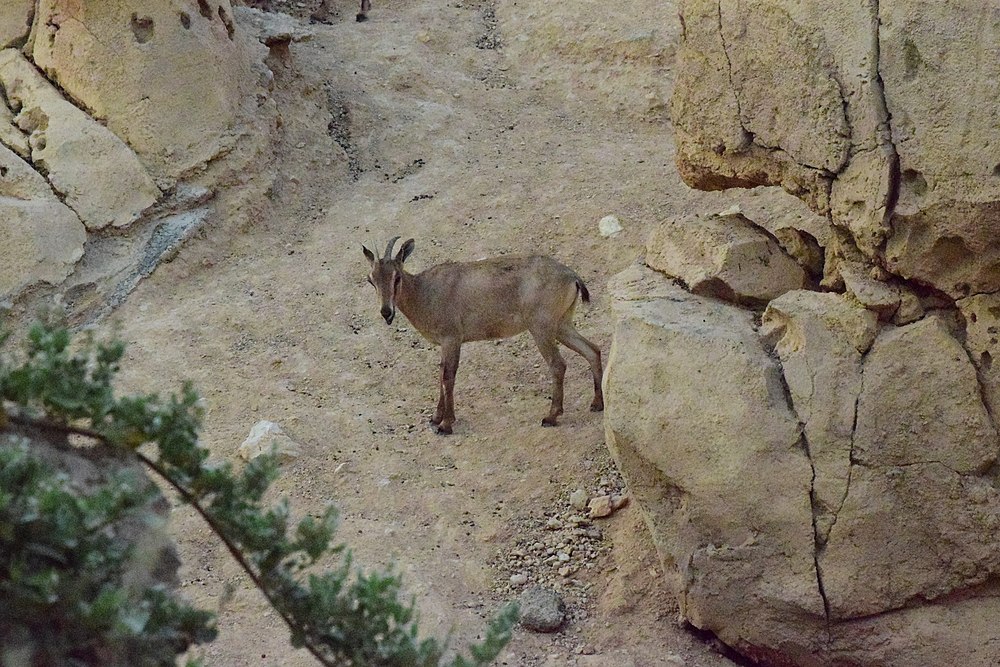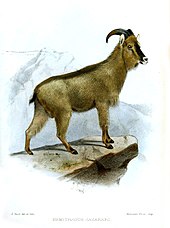| Arabian tahr | |
|---|---|

| |
| Tahr at Al Ain Zoo near Jebel Hafeet in the UAE | |
| Conservation status | |
 Endangered (IUCN 3.1) | |
| Scientific classification | |
| Domain: | Eukaryota |
| Kingdom: | Animalia |
| Phylum: | Chordata |
| Class: | Mammalia |
| Order: | Artiodactyla |
| Family: | Bovidae |
| Subfamily: | Caprinae |
| Tribe: | Caprini |
| Genus: | Arabitragus Ropiquet & Hassanin, 2005 |
| Species: | A. jayakari |
| Binomial name | |
| Arabitragus jayakari (Thomas, 1894) | |

| |
| Distribution of the tahr in the region of the Hajar Mountains of Oman and the UAE in Eastern Arabia | |
| Synonyms | |
|
Hemitragus jayakari | |
The Arabian tahr (Arabitragus jayakari) is a species of tahr native to eastern Arabia. Until recently, it was placed in the genus Hemitragus, but genetic evidence supports its removal to a separate monotypic genus, Arabitragus.
Description
It is the smallest species of tahr. It is of stocky build with backward-arching horns in both sexes. Males are much more robust than females. Their coats consist of a long, reddish-brown hair, with a dark stripe running down the back. Males possess the most impressive manes which extend right down the back and grow longer, based on the age. In the oldest males the muzzle darkens to black and the eye stripes also darken. As with most goat-antelopes, they have rubber-like hooves to provide balance and traction on the steep, rocky slopes.
As of a 2018, the wild population is thought to comprise around 2,200 individuals.
Habitat and range
See also: Musandam PeninsulaThe Arabian tahr lives on steep rocky slopes of the Hajar Mountains in Oman and the United Arab Emirates, at altitudes up to 1,800 m (5,900 ft) above sea level. It is also found in the area of Jebel Hafeet.
Taxonomy

The Arabian tahr was first described in 1894 by Oldfield Thomas who proposed the name Hemitragus jayakari for zoological specimens collected in Oman Jebel Taw. It was separated into the newly created genus Arabitragus in 2005 on the basis of a study on the molecular phylogeny of the group.
Etymology
The genus name Arabitragus is derived from the Greek words aravikós meaning "Arabian" and trágos meaning "goat".
Behaviour and ecology
Unlike other species of tahr, the Arabian tahr is solitary or lives in small groups consisting of a female and a kid, or a male. Instead of forming herds during seasonal ruts, reproduction occurs in small, dispersed family units. Births have been reported as occurring throughout the year, and gestation lasts from 140–145 days.
Diet and predation
These animals are usually browsers, feeding on grasses, shrubs, leaves, and fruits of most trees. They are highly dependent on water and need to drink every two to three days during summer. They descend from their point of elevation to drink from river courses known as wadis, and travel to new areas when water dries up.
The tahr was likely preyed upon by the Arabian leopard (Panthera pardus nimr) before the leopard's possible extirpation from the region in recent times.
Threats
The Arabian tahr is endangered due to intense overgrazing, poaching, and habitat destruction. In Oman, a recent increase of human migration to urban areas has resulted in domestic goats becoming feral and foraging in places that were once strictly the tahr's home. Habitat degradation is also another major threat, due to construction of roads, buildings, and mineral extraction. Also, poaching often occurs when the animals descend down from the mountains for water.
Conservation
See also: Al Hefaiyah Conservation CentreIn 1973, efforts were planned to protect the Arabian tahr, and in 1975, a protection program was introduced in the Hajar Mountains. In 1980, a captive-breeding program was set up at the Omani Mammal Breeding Center to reintroduce captive-bred individuals back into the wild. Three institutions are now involved, one in Oman and two in the United Arab Emirates. In April 2009, the Wadi Wurayah preserve in the Emirate of Fujairah was set aside by royal decree in the Emirates for the protection of the tahr. Another place in the UAE, Sir Bani Yas in the Emirate of Abu Dhabi, was also set up for its conservation.
See also
References
- ^ Ross, S.; Al-Rawahi, H.; Al-Jahdhami, M.H.; Spalton, J.A.; Mallon, D.; Al-Shukali, A.S.; Al-Rasbi, A.; Al-Fazari, W.; Chreiki, M.K. (2019) . "Arabitragus jayakari". IUCN Red List of Threatened Species. 2019: e.T9918A156925170. doi:10.2305/IUCN.UK.2019-1.RLTS.T9918A156925170.en. Retrieved 18 February 2022.
- WAM (2017-09-13). "EAD raises awareness on Abu Dhabi's natural heritage at ADIHEX 2017". The Gulf Today. Archived from the original on 2018-03-30. Retrieved 2018-03-30.
- De Leon, J. P. (2014-05-26). "100th Arabian tahr, and twin tahrs welcomed in Al Ain". Gulf News. Retrieved 2018-04-03.
- ^ "Newborn Arabian tahr discovered on Jebel Hafeet". The National. 2015-03-12. Retrieved 2018-03-30.
- Smit, J. (1894). "Hemitragus jayakari". Proceedings of the Zoological Society of London (May): 534.
- Thomas, O. (1894). "On some specimens of mammals from Oman, S.E.Arabia". Proceedings of the Zoological Society of London (May): 448–455.
- Ropiquet, A. & Hassanin, A. (2005). "Molecular evidence for the polyphyly of the genus Hemitragus (Mammalia, Bovidae)". Molecular Phylogenetics and Evolution. 36 (1): 154–168. Bibcode:2005MolPE..36..154R. doi:10.1016/j.ympev.2005.01.002. PMID 15904863.
- Liddell, H. G.; Scott, R. (1940). "ραβία". A Greek–English Lexicon (Ninth ed.). Oxford: Clarendon Press.
- Liddell, H. G.; Scott, R. (1940). "τράγος". A Greek–English Lexicon (Ninth ed.). Oxford: Clarendon Press.
- ^ Edmonds, J.-A.; Budd, K. J.; Al Midfa, A. & Gross, C. (2006). "Status of the Arabian Leopard in United Arab Emirates" (PDF). Cat News (Special Issue 1): 33–39.
- "Arabian Tahr gets royal protection". WWF. 2009. Archived from the original on 2018-09-13. Retrieved 2018-03-30.
- "Endangered Arabian tahr born on Sir Bani Yas Island". Gulf News. 2018. Retrieved 2018-04-02.
External links
![]() Media related to Arabitragus jayakari at Wikimedia Commons
Media related to Arabitragus jayakari at Wikimedia Commons
| Taxon identifiers | |
|---|---|
| Arabitragus jayakari | |
| Hemitragus jayakari | |